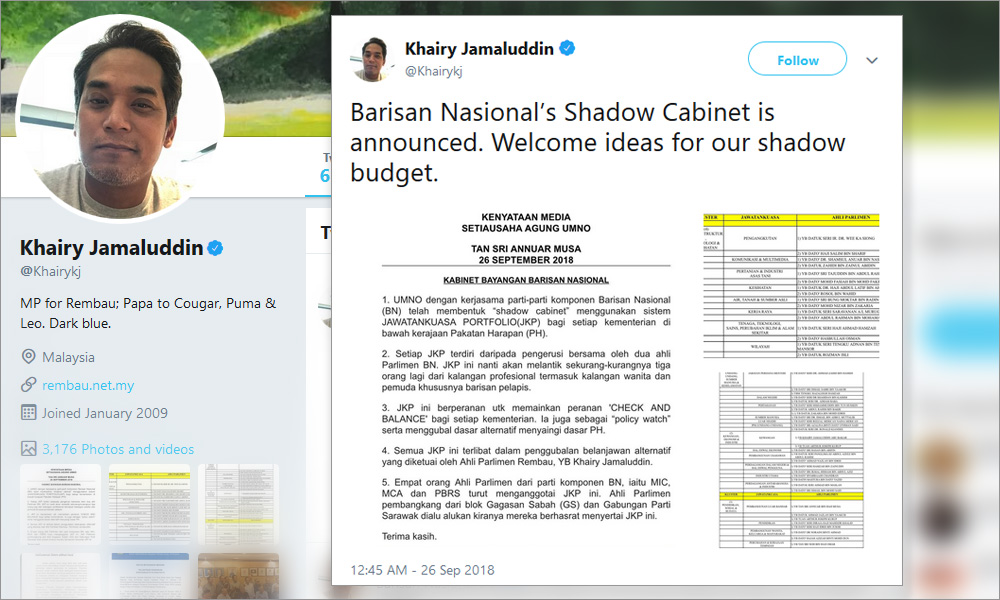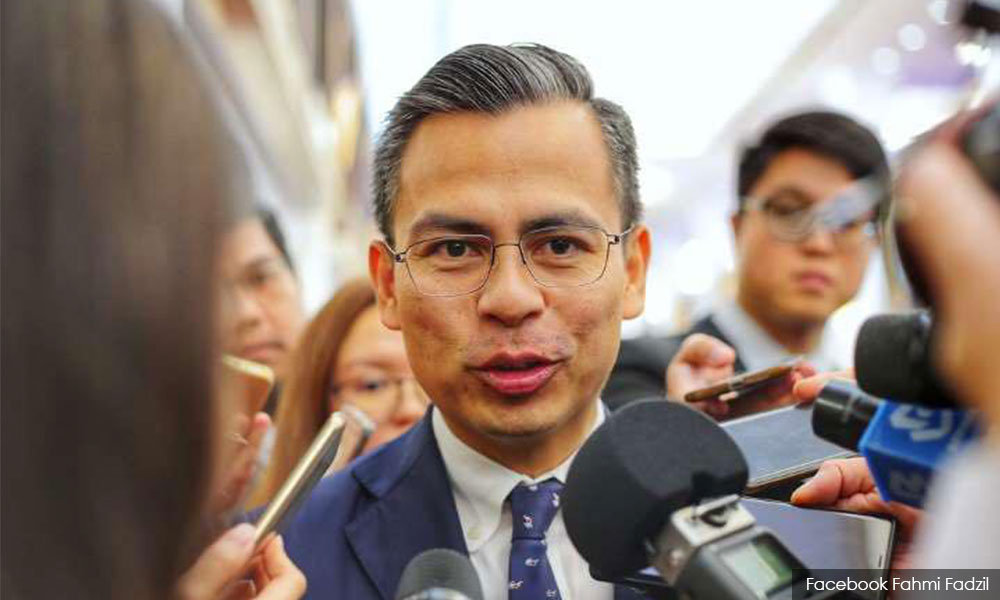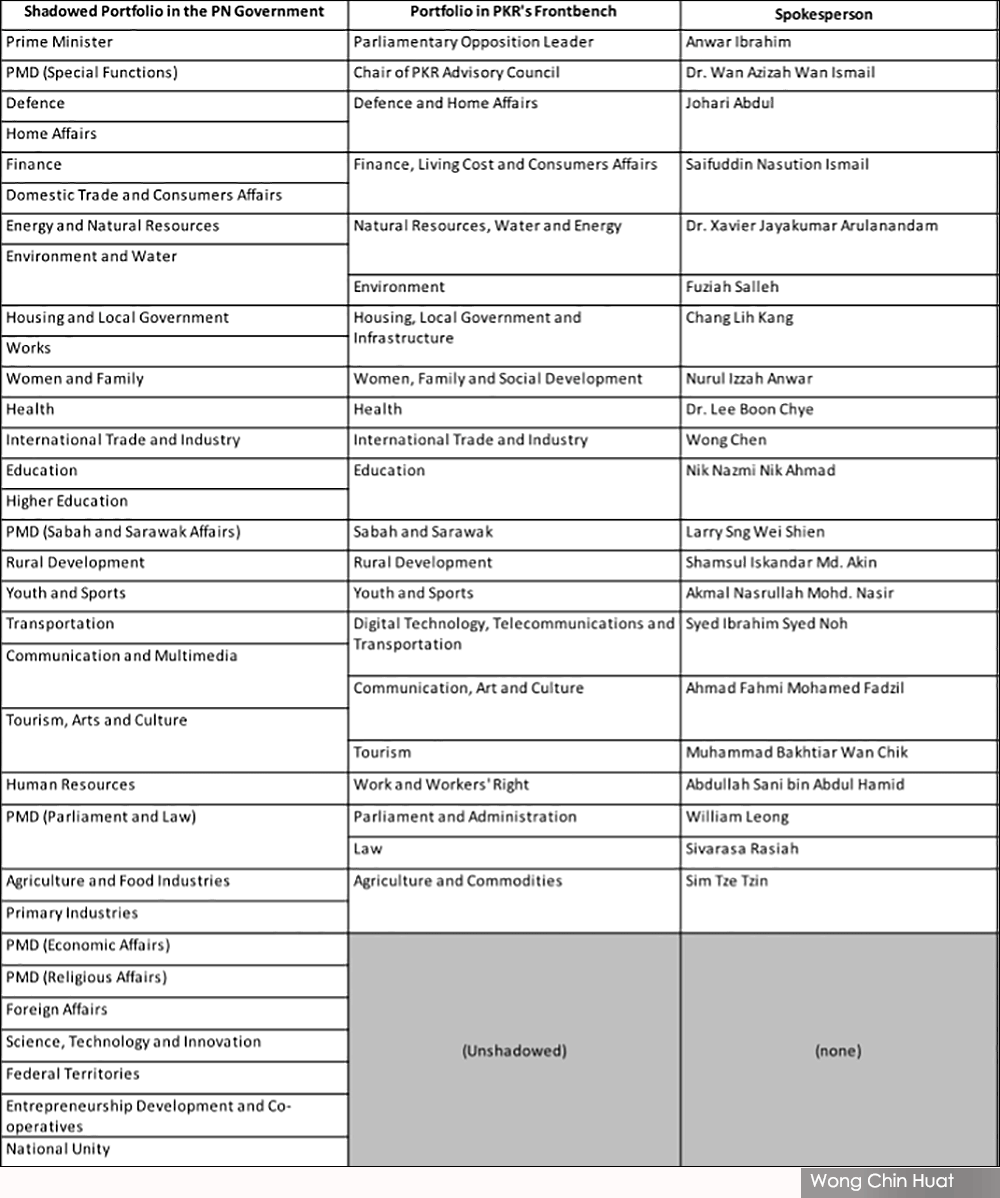
On Friday, PKR announced a line-up of 19 parliamentary spokespersons led by PKR president Anwar Ibrahim and the party's advisory council chairperson Dr Wan Azizah Wan Ismail to shadow the cabinet and 17 MPs as assistant spokespersons.
This division of labour is effectively PKR’s “shadow cabinet”, without the name.
While this has met the call from civil society for the opposition to have a shadow cabinet to effectively check and balance the executive, three questions have also been raised against the move.
First, will it work when the previous attempts have failed?
Second, is the line-up fitting in terms of competence and diversity?
Third, and most importantly, why is it a PKR instead of a Pakatan Harapan or Pakatan Harapan Plus line-up?
These are legitimate questions that deserve serious answers from PKR, Harapan and Harapan Plus as well as external scrutiny. As a staunch advocate of a shadow cabinet, I will volunteer to do the latter.
Can it work when previous attempts have failed?
Two attempts to shadow the government had been made before this, but both failed miserably.
In September 2018, Malaysia’s inaugural “shadow cabinet” by the official opposition was announced by BN, with 52 of its 53 MPs (of which 26 were shadow ministers), with Najib as the only MP left out.
Similar to PKR’s “assistant spokespersons”, this round, all “backbenchers”, were made deputies.

Nine years earlier, in July 2009, Pakatan Rakyat put all its 82 MPs into 25 ministerial committees, with PKR, PAS and DAP representatives in each of them, but categorically denied it being a “shadow cabinet”.
For shadow cabinets to work, first there must be a real division in labour, to avoid parliamentarians becoming “a jack of all trades but master of none”.
This would avoid a repetition of inexperienced or incompetent ministers in Harapan’s 22 months.
Next, there must be a real separation of the frontbench and the backbench. Pakatan Rakyat’s ministerial committees were set to be a failure right at the start because all committee members were equal.
Is PKR’s “shadow cabinet” real? One simple indicator: will there be a weekly meeting of the ministerial spokespersons chaired by Anwar himself, to shadow the weekly cabinet meeting?
BN’s shadow cabinet never worked because Ahmad Zahid Hamidi (photo), its shadow PM, never took it seriously to call weekly meetings.

With online applications like Zoom, this can be done effortlessly. If Anwar meets his shadow ministers weekly, his 21-member frontbench will become the effective power centre of PKR, as cabinets are for the BN, Harapan and Perikatan Nasional governments.
Important decisions by PKR will be made in the weekly shadow cabinet meeting. Alternative policies by the spokespersons will be similarly announced after agreement by the whole shadow cabinet.
Once this is institutionalised, the media will await PKR’s shadow cabinet meetings and PKR can shrug off the perception that PKR is but Anwar’s personal cult.
The media should press Anwar or the party's Communications, Art and Culture spokesperson Fahmi Fadzil (below) for the date of his first shadow cabinet meeting to know if PKR is serious about this frontbench line-up.

Next, Anwar, as the parliamentary opposition leader, should press Prime Minister Muhyiddin Yassin - whom he admitted he had met - for recognising the shadow cabinet so that shadow ministers can have better access to government information to formulate alternative policies.
Anwar should also press for more parliamentary committees to scrutinise the Parliament.
For now, only eight of 30 ministerial portfolios in the cabinet are scrutinised by five special select committees in the Dewan Rakyat.
Important portfolios like education, health, transportation, housing, youth, communications and human resources are all not scrutinised.
Is the line-up fitting in terms of competence and diversity?
PKR’s 21 frontbenchers shadow 25 ministerial portfolios in the PN government, leaving behind seven portfolios unshadowed: economics affairs; religious affairs; foreign affairs; science, innovation and technology; federal territories; entrepreneurship development and co-operatives; and national unity.
The 21-member line-up consists of one former deputy prime minister, two former ministers, six former deputy ministers, the former government’s chief whip and four chairpersons of parliamentary special select committees (PSSCs). The remaining seven are members of the Public Accounts Committee (PAC) or some PSSCs.
Leaving aside Sabah Deputy Chief Minister Christina Liew, the 17 “assistant spokespersons” are mostly junior backbenchers. There are four notable exceptions: Hassan Karim (chairperson of the PSSC on state and federal relations), Nor Azrina Surip (chairperson of the PSSC on gender equality and family development), Maria Chin Abdullah (chairperson of the all-parties parliamentary group on sustainable development) and Dr Tan Yee Kew (a former parliamentary secretary during BN’s time).
The frontbench is a good mix in age group and communal representation but falls short in gender balance with only 14 percent of women, even slightly lower than 16 percent in the Harapan government.
PKR’s spokespersons and the shadowed portfolios in the PN government

While the line-up may not be flawless, the key issue here is whether Anwar will reshuffle his frontbench in the coming months if some of his spokespersons sleep on the job or are outperformed by their backbench colleagues.
Why is it a PKR and not a Harapan shadow cabinet?
To offer the public an alternative to PN, there must ultimately be a Harapan Plus or at least a Harapan shadow cabinet.
While we wait for explanation or further announcement from Harapan, here are two possible scenarios that may explain the absence of a Harapan Plus shadow cabinet.
First, other Harapan Plus parties - DAP (42 seats), Amanah (11), Warisan (nine), Dr Mahathir Mohamad’s bloc (six), Parti Sarawak Bersatu (two) and Upko (one) – may want a package deal that includes the candidates for prime minister and deputy prime ministers.
Second, these parties want to leave the options wide open for GPS, which Harapan Plus has been courting since March to oust Muhyiddin.
In the first scenario, a Harapan Plus shadow cabinet may drag on for weeks, if not months, until the deadlock is resolved.
In the second scenario, Harapan Plus may never have a shadow cabinet as the waiting for GPS will continue until GE15 is called.
Instead of wasting more months for a common line-up, it makes more sense for Harapan Plus parties, especially the larger PKR and DAP, to first present their own line-ups before consolidating them through a reshuffle.
GE15 manifesto by the shadow cabinet
As pointed out by senior Selangor state executive councillor Teng Chang Khim (below), Harapan’s manifesto for GE15 should be prepared by its shadow ministers who have now acquired some experiences in government to know what promises may be realistically made and kept.

A delay in shadow cabinet formation may simply mean another manifesto with hastily patched up promises that voters cannot trust, and no serious alternative to PN when GE15 comes.
For all its imperfections, PKR’s shadow cabinet is the first step into the right direction towards the professionalisation of politics, instead of endless bickering over Mahathir, Anwar and now, Shafie Apdal.
However, it may become just another letdown, like the Buku Harapan, if we won’t read soon the news of Anwar’s first shadow cabinet meeting.
If Anwar fails like Zahid did, he will be weaker as a prime minister contender than if he had not started this. - Mkini


No comments:
Post a Comment
Note: Only a member of this blog may post a comment.